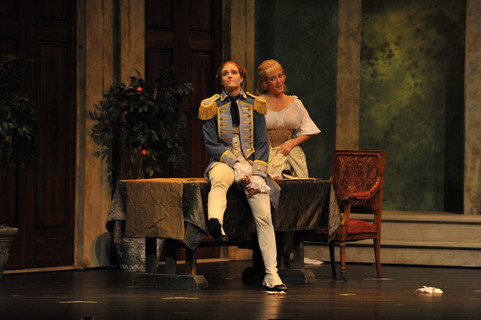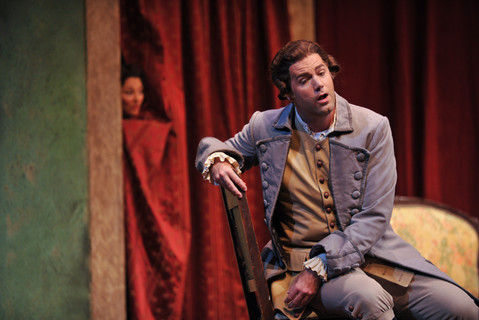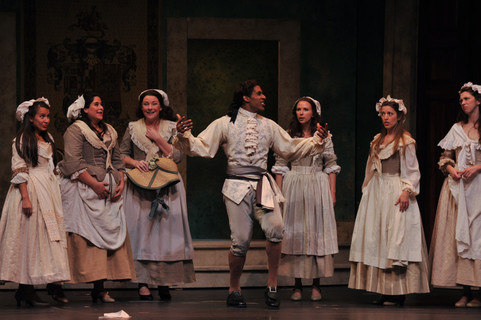FWO Archives: 'The Marriage of Figaro' Program Notes (2012 Festival)
- Fort Worth Opera

- Jul 21, 2020
- 6 min read
Social tensions boil over in this classic battle of the sexes, as Mozart brings Beaumarchais' thinly-veiled attack on the aristocracy to life with some of operas most glorious arias and ensembles. Starring Donovan Singletary, Andrea Carroll, Wallis Giunta, Jonathan Beyer, Jan Cornelius, Kathryn Cowdrick, Rod Nelman, Jamin Flabiano, and Corrie Donovan, this witty comedy was a highlight of the 2012 Fort Worth Opera Festival and remains one of the top 10 operas performed in the world.


Wolfgang Amadeus Mozart’s The Marriage of Figaro (Le Nozze di Figaro) was first performed in Vienna on May 1, 1786. In the five years immediately leading up to its composition, Mozart, a prolific composer in every kid of vocal and instrumental music, had studied the compositions of Bach and Handel, turning out the majority of his greatest piano music. The composer was simply at the height of his powers. French playwright Beaumarchais’ play Le Mariage de Figaro was written in 1778, but was not performed until 1784 due to conflicts with the French censors. The play is a sequel to Beaumarchais’ 1775 play, Le Barbier de Seville, which was also extremely popular and became the basis for a number of other operas – the most famous being Rossini’s version that premiered in 1816.

Mozart’s librettist for The Marriage of Figaro was none other than Lorenzo Da Ponte, the same man who would later adapt texts for Mozart’s Don Giovanni and Cosí fan tutte. While it took six years to get the original play past the censors in Paris, the play was still banned in Vienna where the opera was to premiere, so it took careful planning on Da Ponte’s part to eliminate or de-emphasize the political aspects of the play in order to get it on stage. Beaumarchais’ characters and Da Ponte’s words were the fodder of Mozart, and his sheer genius and abilities turned the work into an operatic masterpiece. In his hands the stock characters became real people.


Stock characters are based in large part on stereotype, relying on an accepted set of personality traits and manner of speaking. In 18lh century writing, using stock characters was particularly popular - since everyone knew the basic types of character, writers could throw them into situations without needing additional character development or background explanations. Writers also took great advantage of the fact that stock characters were unable to change or evolve, which made them ripe for parody.The Italian opera tradition before Mozart made use of stock characters quite a bit, but in The Marriage of Figaro, the players become three-dimensional people regardless of social standing. The cast consists of eleven people, and their positions break down basically into three levels, which is fairly consistent with 18'h-century social standings. The aristocracy consists of Count Almaviva, the Countess, and Cherubino. The lower class consists of the gardener Antonio, his daughter Barbarina, and his niece Susanna. The middle class consists of the Dons Bartolo, Basilio, and Curzio. Figaro and Marcellina are hard to place with precision because they exist somewhere between the working lower class by birth and the middle class profession.

In the old traditions, Count Almaviva's rank in society would have been of primary importance and all of his characteristics and actions would have sprung from his social standing. He would have had no qualms about claiming the “droit du seigneur” (the feudal right of the lord to bed a servant girl on her wedding night), as his behavior would have been more than accepted - it would have been expected. Yet, in Mozart's hands, the Count literally becomes a victim of his own rank. The Count is the feudal lord cursed with the mind of an enlightened man. He spends the entire day trying to reconcile these two aspects of his life, and his aria “Hai giá vinta la causa! …Vedro mentr’io,” expresses his extreme frustration with his fate. He first states suspicion of trickery by his servants, which leads him to question how he should react. The very fact that he poses the questions shows that he is thinking beyond his stock characteristics. And, by the end of the aria, the Count has decided that his misery deserves company. The resulting portrait is a man torn between his two natures, with either side having an equal chance of coming to the forefront.

In truth, the Count's tragic nature (condemned to unhappiness by the confines of his social status), can be seen in the other three major characters as well. The Countess' tragedy is not just that her husband is unfaithful. If she were a stock character, she would be destined to accept her fate passively, and Mozart gives her a heart-wrenching aria, “Porgi amor,” that seems to indicate she is willing to fill that role. However, this woman refuses to be powerless, so like her husband, she faces the idea of fighting what society says she must do. Unlike her husband though, she takes action to change her fate, rather than simply bemoan it. She chooses to succumb to a lower social rank to break free of her fate, but the decision to do so is not an easy one for her as “Dove sono i bei momenti” shows. The aria depicts recognition of true humiliation at appearing to be her maid's (Susanna) equal, but by the end of the aria, the Countess' rank means less to her than the humiliation of a philandering husband. The journey she takes through this one aria is infused with courage and backed by her high moral character, making her choice not only tolerable but also heroic.

Susanna, like the Countess, has to cross the lines of social class, but her movement is upward and calls for a large amount of intelligence for her to accomplish it. Throughout the day, Susanna is the one character who manages to strike the right tone with everyone, regardless of social standing, and the way that Mozart composed for her in each ensemble piece, her vocal line takes precedence, showing her control of every situation.

By the time we hear her “Deh vieni, non tardar” in Act IV where she is punishing Figaro with the idea of an affair, the audience knows her to have multiple sides to her personality, which is not to say she is two-faced. In fact. Susanna could have very easily allowed the Count to seduce her and then use his two-sided nature to control him - she has the intelligence and skill to do it. Instead, the very modest goal of marrying Figaro is the only thing that drives her.
In this opera, the problem with Susanna's beau, Figaro, is that he lacks the insight she has in spades. In Beaumarchais' first play with Figaro, the character is very clever, so much so that Don Bartolo's resentment towards Figaro's interference with his plans lingers into this sequel. However, in The Marriage of Figaro, Figaro's cunning fails him. From the very beginning of the opera, when the Count's real reason for housing Susanna close to his quarters eludes Figaro, his intelligence is definitely called into question, and despite most of the plans he invents to trick the Count. Figaro simply does not have the ability to outwit the aristocracy, while Susanna does.

Figaro's frustration with the situation begins with “Se vuol ballare, signor contino” in which he states with absolute confidence that he can outsmart the Count. but by the end of the day dissolves into “Aprite un po'quegli occhi” in which frustration with his failed schemes manifests itself by him denouncing not just Susanna, but all women. Figaro, like the Count, seems to be railing against the social system that he cannot beat at this point.

The Marriage of Figaro has innumerable levels to it, as any masterpiece should, and while the social tension among the classes are a big part of it, Mozart’s version (as opposed to the original play) was not intended to call for social change. Each character has strengths and weaknesses that the composer does not overemphasize or sugarcoat. The true genius of Mozart was taking these characters and making them human, but also making us laugh at them (and with them) along the way.
Director of the Fort Worth Opera Studio/ Education, Hannah Smith earned her master’s in musicology and bachelor’s in vocal performance from Texas Christian University. Before joining FWOpera in 2008, she worked for the Van Cliburn Foundation, where among other duties, she was editor for all their printed materials.

Watch the TheaterJones interview with the cast of The Marriage of Figaro
The Marriage of Figaro
Music by Wolfgang Amadeus Mozart
Libretto by Lorenzo Da Ponte
After the stage comedy by Pierre Beaumarchais
Sung in Italian
Conductor Steward Robertson
Director Eric Einhorn
Scenic Designer Michael Wingfield
Costume Designer Allen Charles Klein
Lighting Designer Chad Jung
Make & Wig Designer James P. McGough
Stage Manager Joe Gladstone
Assistant Director Andrew Nienaber
Repetiteur & Harpsichordist Emily Jarrell Urbanek
English Supertitle Translation Keith A. Wolfe
Spanish Supertitle Translation Gabriela Lomónaco
Featuring The Fort Worth Symphony Orchestra
The Cast in Order of Vocal Appearance
Figaro Donovan Singletary
Susanna Andrea Carroll
Don Bartolo Rod Nelman
Marcellina Kathryn Cowdrick
Cherubino Wallis Giunta
Count Almaviva Jonathan Beyer
Don Basilio Jamin Flabiano
Countess Almaviva Jan Cornelius
Antonio Joel Herold
Don Curzio Logan Rucker
Barbarina Corrie Donovan
GALLERY
All photos by Ellen Appel.












































































Comments